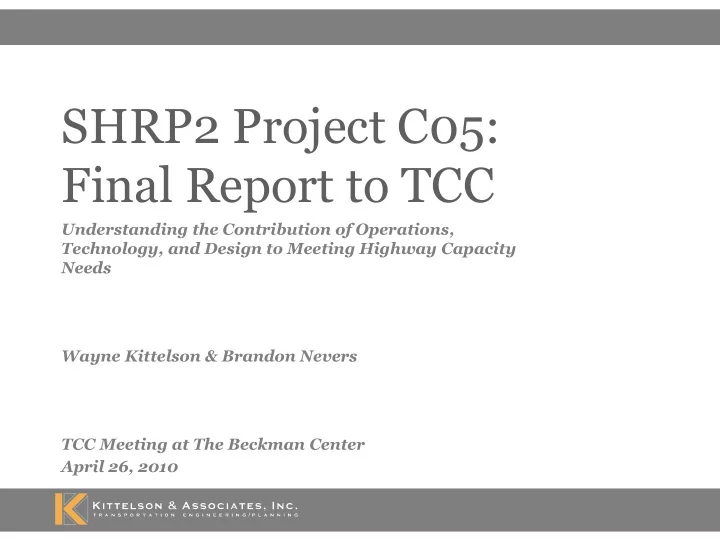

SHRP2 Project C05: Final Report to TCC Understanding the Contribution of Operations, Technology, and Design to Meeting Highway Capacity Needs Wayne Kittelson & Brandon Nevers TCC Meeting at The Beckman Center April 26, 2010
Presentation Overview Project Scope, Objectives, and Timeline Key Findings Key Products Response to TCC Feedback of Spring 2009 Schedule for Completion
Project Scope and Objectives Quantify capacity benefits of improvements at the network level Provide information and tools to analyze operational improvements as an alternative to traditional construction Develop guidelines for “sustainable service rates” to be used in planning networks
Project Timeline
Non-Lane Widening Strategies to Improve Capacity Freeway Arterial Both HOV Lanes Signal Retiming Narrow Lanes Ramp Metering Signal Coordination Reversible Lanes Ramp Closures Adaptive Signals Variable Lanes Congestion Pricing Queue Management Truck Only Lanes Pricing by Distance Raised Medians Truck Restrictions HOT Lanes Access Points Pre-Trip Information Weaving Section Right/Left Turn In-Vehicle Info Channelization Frontage Road Alt LT Treatments VMS/DMS Interchange Modifications
Insights on Strategy Effectiveness Effectiveness needs to be tested in network context – Requires the use of a travel demand/DTA model – Cannot be done with static look-up tables Impacts most pronounced at the link and corridor levels, and often difficult to see at the network level – Demand-side issues are best viewed from an O-D perspective – Supply-side issues are best viewed at the link and corridor level Pre-trip information can reduce buffer time – En-route information may create instabilities
Key Products Traffic Model Enhancements Diagnostic Tools Strategy Evaluation Results Spreadsheet-Based Model Final Report Guidebook
Traffic Model Enhancements: Stochastic Capacity for Freeway Bottlenecks
Traffic Model Enhancements: Stochastic Capacity for Arterials
Traffic Model Enhancements: Day-to-Day Traveler Learning Traveler’s route choice is based on experiences remembered from the past two weeks Limits applied to number of travelers who will adjust their trip each day Expected to be important in the evaluation of non- recurring congestion
Traffic Model Enhancements: Improved Bottleneck Representation Merges Short Turn Pockets
Diagnostic Tools: Active Bottleneck Identification
Diagnostic Tools: Movement-Specific Intersection Delay Display
Diagnostic Tools: Stochastic Link Performance and Breakdown Probability Visual representation currently being developed Breakdown probabilities estimated from recorded simulated experience
Overview of Strategy Testing Plan Testing plan developed for 25 strategies – Location within the DFW network – Geometric, volume, and operational inputs – Selection of performance evaluation MOE’s Test Protocol – I: Baseline stabilization – II: Strategy stabilization – III: 20-day results comparison period I II III
Strategy Evaluation Results: Equivalent Capacity Gain Concept
Capacity Addition Scenarios (Southbound Freeway Corridor) Baseline # A B C of Lanes Lane-Mile Addition +8.5 (+24%) +16.0 (+46%) +7.6 (+22%) 4 5 1.9 miles 1.9 miles 5 6 0.9 miles 0.9 miles 5 6 8.5 miles 8.5 miles 5.7 miles 5.7 miles 5 4 17
20-Day Average Results Travel Times 16 14 95 th percentile TT Travel Time (Minutes) 12 5 th percentile TT 10 8 Reversible Lane ATIS En-route Narrow Lanes * 6 ATIS Pre-trip A (+22%) B (+24%) C (+46%) 4 Baseline 2 0 * Effects in peak direction with lane addition for one hour 18
20-Day Average Results Travel time index 0.0 0.2 0.4 0.6 0.8 1.0 1.2 1.4 1.6 1.8 2.0 Baseline ATIS Pre-trip ATIS En-route Travel Time Index Narrow Lanes Reversible Lane A (+22%) B (+24%) C (+46%) 19
20-Day Average Results Buffer index -0.1 0.0 0.1 0.2 0.3 0.4 0.5 0.6 Baseline ATIS Pre-trip ATIS En-route Buffer Index Narrow Lanes Reversible Lane A (+22%) B (+24%) C (+46%) 20
Spreadsheet Application: Network Simplification is Required 1 Primary OD: 1→2 (Southbound) Freeway # Zone Number 2 21
Spreadsheet Application: Uses Simplified Travel Time Profiles D: Good day on freeway E: Bad day on freeway A: Arterial street (we do not have randomized capacity on arterial street yet) 22
Spreadsheet Application: Results Are First Approximation 50 Average Travel Time (min) Expected Value 45 40 Perfect Information 35 System Optimum 30 Add 1 lane 25 20 15 10 5 0 0 2000 4000 6000 8000 10000 12000 Demand Level (vhc/hour) 100 random scenarios (i.e. days) using calibrated stochastic capacity model from C05 Deterministic demand Two corridors – Route A: 2 lanes, free-flow travel time: 20 min – Route B: 3 lanes, free-flow travel time: 40 min 23
Response to TCC Feedback (Spring 2009) Validation on a bona fide network will increase comfort and add credibility Ability to model nonrecurrent congestion will make the tool substantially more useful to users and decision- makers
Portland Network: C05 Subarea Boundary
Portland Network Statistics Entire Network Subarea Network Traffic Analysis Zones 2,013 208 Nodes 9,905 857 Links 22,748 1,999 Vehicles 1.2 M 212 K Average Travel Time 22 min 14 min Demand Horizon: 4 hours ( 15:00-19:00 )
Application Notes DTA modeling enhancements have been coded into two separate DTA models – Dynasmart-P v. 1.2(E) – DTA Lite Method: – Calibrate the entire network using DTA Lite – Apply DSP to the smaller subarea Current status: – DTA Lite network calibration is complete – DSP has recreated subarea base condition results – Diagnosis and evaluation of treatment options underway
Portland Subarea: Identified Active Bottlenecks
Adding Non-Recurrent Congestion Capability Develop strategy to represent effects of nonrecurring congestion Produce necessary software code Apply enhanced model to Portland network Summarize/document findings
Final Report Outline Executive Summary 1. Introduction 2. Improved Methods for Modeling Network 3. Performance – Measurement and Modeling of Network Performance – Uninterrupted Flow Facilities – Interrupted Flow Facilities Strategies for Enhancing Sustainable Service Rate 4. on Freeways and Arterials Prototype Application of Methods, Metrics, and 5. Strategies
Schedule for Completion Portland Network May 15 Draft Final Report June 30 Draft Guidebook June 30 Project Completion September 30
Recommend
More recommend